[Retracted] Intelligent Building Space Layout and Optimization Design Method Based on Biological Population Simulation
Abstract
Smart buildings can store various types of data, analyze data at a faster speed, and quickly provide users with the most accurate and high-quality intelligent services through technical means. The main purpose is to meet the needs of users, to provide communication and a series of knowledge services for all professional participants, and to provide comfortable working resources and working environment for all professional participants to ensure the smooth implementation of the project and meet the construction engineering requirements. In this study, the spatial layout and optimization of intelligent buildings are carried out based on biological population simulation, and the following conclusions are drawn: (1) The emergence of multicore or multicore graphics converters reduces the cost and popularity of high-performance software platforms, and provides faster computing speeds for applications. A new platform and implementation method have been developed. Comparing marine biopopulation models relies on the i4Ocean platform. The i4Ocean platform is a computer platform for seascape information and virtual reality applications, including view management, production engine, and MVC core framework. (2) The swarm model simulates the movement of fish in a virtual ocean. Determine their behavioral changes based on determined behavioral conditions (e.g., in position, position, and velocity). As everyone in the group moves, the entire group is monitored for behavior. (3) Intelligent buildings involve many aspects of the social machine, such as building construction, which not only affects architecture, but also design. Smart construction helps improve quality, shorten production time, save resources, and control costs. It is an important part of the structural transformation of the supply side of the construction industry, and an important tool for the structural adjustment and modernization of the construction industry and greenhouses. (4) X2View is like the most popular configuration king, with integrated functions. Project software is placed on the X2View and sent to the door or touch screen for processing and monitoring. In the driver configuration interface, you can set the application frame time of the monitoring node and the real-time measurement time of the record value recording time frame.
1. Introduction
With the development of the economic level, the scale of houses is increasing, and the construction technology is becoming more and more mature. Traditional construction methods cannot meet complex construction requirements [1]. Smart building is a new concept that emphasizes sustainable development, energy conservation and reduction of enclosed gas emissions, protection of natural resources, and core management of greenhouses. Use modern tools to implement a full range of cleaning. Smart buildings require specific applications to integrate new information technologies and the construction industry. 4D-CAD and BIM technology integrate building material information model, conduct dynamic research and statistical analysis on the relationship between technical cost materials and construction progress, help understand the progress of project implementation, and quickly detect and solve the relationship control between structures. Resources and costs improve project management level and efficiency [2]. In the detailed analysis of lean manufacturing, an interaction matrix is established, their interactions are discussed, individual interactions are analyzed, and future application projects of lean manufacturing and BIM technology are compared. Analyze the advantages and disadvantages, and prepare a similar interaction matrix. The collaborative application of dynamic manufacturing and BIM technology is proposed, and the negative impact of the combination of the two is avoided as much as possible [3]. Based on new information technologies such as BIM, Internet of Things, personal data processing, and 4D vision, considering the concept of smart home, there are more and more management methods for smart homes and more and more management methods and processes. With the improvement of scientific and technological level and the promotion of new information technology, the traditional construction industry has introduced a new construction mode. The new building model combines IT building construction technology with digital and intelligent building construction. Smart city is an important part of urban architecture [4]. According to the characteristics of the current construction industry, in order to better stimulate its survival, the main goal is to use the high-tech system innovation of the construction industry to promote the intelligent development of housing. In recent years, the concept of smart home has been considered and continuously improved [5]. The evaluation standard requires intelligent buildings to implement the concept of sustainable development, with low-carbon combustion and environmental protection as the main goals of the project. All participants in the Environmental Assistance Program have a collaborative platform for providing information. Smart building is a good platform [6], and the smart home platform is supported by BIM technology, cloud technology, and Internet of Things technology. All these technologies operate on a huge IT database that can be understood through the integration of traditional manufacturing tools and information technology [7]. Smart buildings usually focus on five major information technologies, such as BIM technology, cloud computing, and mobile Internet, solve key problems in various fields of construction projects, and create a knowledge-based office environment with multiteam participation and collaborative development. The main goal is to meet the needs of owners. Intelligent building is a form of construction with similar characteristics of the times, which is different from traditional construction forms. Based on the organizational structure, knowledge construction requires all participants to work together on a project [8], sharing information on a knowledge platform to make the project more meaningful and effective. In the field of machine quality and safety management, traditional manufacturing organizations have formulated a number of quality and safety management systems and appointed multiple quality and safety inspectors to manage the factory [9]. With the help of information technology, it is possible to monitor the construction site at any time, reduce operations, and provide an alarm response when problems arise. The use of visual simulation technology for construction sites must be addressed where problems arise. For project cost, statistics used to provide correct machine size for project cost. Then, compare it to the timeline to make sure people, equipment, machinery, and equipment are properly organized. For information sharing [10], a knowledge base is established to collect information about projects in various ways and to incorporate professional information and resources provided during the development of professional projects into appropriate times. The types of services and applications in a building are location-based, and each location can only access nearby locations and control the data interaction between nearby locations [11]. From the perspective of behavior process, group behavior and group robot formation are similar in operation. Individuals in a group cannot simply follow the global extension law, and may be affected by factors such as individual behavioral characteristics. To show that individuals in a sample can be combined, combinations must be considered. Aggregation is an idea of the aggregate strength of a group, the final size of the aggregate of the group. The smaller the final size, the greater the density of the aggregated population and the stronger the aggregation. Individuals in the herd moved to one location over a period of time, but it was not stated whether the individuals would remain in the herd area or remain active in the area. This should also be investigated in cluster models to determine the ultimate nature of the individuals. Stability analysis of the samples was performed [12]. The stabilization time of the population is related to the initial position of the individual, and in the simulation test, the initial position of the individual is determined by a set of random values. When studying the cluster confirmation time through the simulation test, for each set of parameters, the average value of multiple tests was taken as the cluster confirmation time under the set of parameters. The herd stabilization time could not be determined to minimize error in test results. Thousands of simulations are often used, such as video games, virtual reality, security simulations, and movie animations. A range of methods has been developed to achieve reliable and efficient simulations of group behavior. The way in which the model is applied is unique to each client [13]. Most groups are small groups of many people with similar behaviors. There is a way to compare the properties and behavior of subgroups within a group. These methods focus more on controlling for comparative group formation rather than natural group behavior in the real world. Some current data collection methods, such as motion capture tools or methods to automatically retrieve walking trajectories from group video tapes, are difficult to obtain the real group motion data required in a data-driven process. Researchers have systematically studied the research theories, cutting-edge technologies, related software systems, and new intelligent tools and software of intelligent computers required for new buildings and their applications and are constantly improving and maturing [14]. Most swarm simulation techniques are based on some form of intelligent control optimization technology, which uses intelligent optimization technology to reflect the uniqueness of swarm space group simulation. Able to represent the variability of multiple objects and the variability of motion, but the computational cost is very high. There are also algorithms that compare the characteristics of insects in the environment, such as ant colonies and bee colonies. To a certain extent, it can exhibit some form of group behavior, but in some specific cases, it is likely to collapse, such as the whirlpool ant, a phenomenon caused by a high dependence on the ant colony. Intelligent building grouping is the process by which people in a group cooperate with each other to make all intelligent actions happen. Simulated physics methods were originally considered for the construction operations of swarm robots. Use the law of universal extension to define how individuals interact. Through this interaction, the robots come together and share unique structures and geometries. Intelligent buildings are very in line with the concept of sustainable development, integrating life into all aspects of the project life cycle, using information technology to consume energy and green production, and can control the recycling of natural resources [15]. Sustainable development not only meets the requirements of power protection and environmental protection, but also meets the requirements of social and urban development.
2. Swarm Simulation and Intelligent Building
2.1. Group Motion Model
The global clustering model is to analyze and compare the comparative clusters. Models based on global control can better compare individual groups and have significant advantages in both model-by-model and overall planning and presentation. Since the group has been extracted as fine particles, it is suitable for massive parallelism. In the calculation, the more the number of particles, the higher the calculation speed. The disadvantage is that the group modeling cannot reflect the characteristics of individual behavior significantly, and the individual model is general. A form of collective action occurs when everyone demonstrates his or her own action. Individual group simulation can be adjusted individually for individual actions and attribute parameters. The complex and changeable group behavior can be understood through a small amount of local control, and it can be shown in different actions, which has a good simulation effect. And individual models are better and more efficient. Individual comparisons are used to simulate the movement of schools of fish, such as fish in an aquarium and sheep on grass. It is shown in Figure 1.
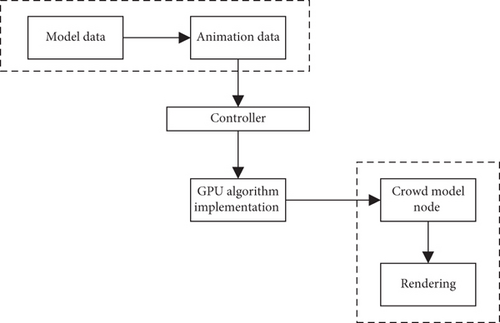
2.2. Intelligent Construction
There is a big difference between smart construction and traditional construction. Smart buildings can provide intelligent services to all project participants throughout the life cycle of the project. Data warehouse can store various types of data, analyze data at a faster speed, and quickly provide users with the most accurate and high-quality intelligent services through technical means. By considering the complex types of information that emerge from the perspective of knowledge creation, different types of communication, interaction and advancement are allowed to achieve the goal of knowledge. The Internet of Things technology is applied to the intelligent platform, through the interaction between people, to create an intelligent neural network platform, to strengthen the communication between different users, to avoid island communication, and to achieve synergistic benefits. Integration is a feature of intelligent construction projects and technology integration, to complete the integration of various information technologies and to integrate the core functions of construction projects. Technical support for smart manufacturing includes a variety of tools and unique features. The advantage of smart construction projects is the combination of different technical approaches to achieve the highest level of integration. The main purpose of smart buildings is to meet the needs of users, to provide communication and a series of knowledge services for all professional participants, and to provide comfortable working resources and working environment for all professional participants to ensure the smooth implementation of the project and meet the requirements of the construction engineering supervisor. Many issues arise after the project is completed (building management, building renovations, building operational renovations, etc.), and expert services are also available. It is shown in Figures 2 and 3.

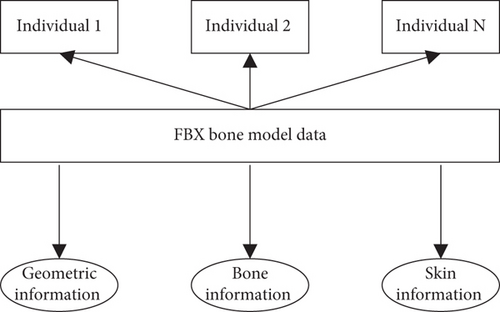
3. Simulation Algorithm
4. Simulation Experiment
4.1. Swarm Algorithm Based on GPU Implementation
With the continuous expansion of the scale of the band, the derived computer platform, computer speed has become one of the main evaluation indicators of algorithm liquidity. As shown in Table 1 and Figure 4, the initial detection values of CI parameters are S11 = 1.61, S12 = 1.97, S13 = 0.48, S21 = 1.99, S22 = 1.26, S23 = 1.74, S24 = 6, S31 = 9, S32 = 6, and S33 = 10. The emergence of multicore or multicore graphics converters reduces the cost and popularity of high-performance software platforms and provides new platforms and implementation methods for faster computing speeds for applications. Comparing marine biopopulation models relies on the i4Ocean platform. The i4Ocean platform is a computer platform for seascape information and virtual reality applications, including view management, production engine, and MVC core framework. The initial detection values of BIO are S11 = 1.43, S12 = 1.89, S13 = 1.22, S21 = 1, S22 = 0.64, S23 = 1.14, S24 = 6, S31 = 10, S32 = 10, and S33 = 6. The MVC core code of the basic layer combines the basic code and the application layer code, improves the MVC core framework of application development based on platform architecture, and supports GPU accelerated display interface. The i4Ocean platform has ocean data views, as well as 3D seascape simulations, especially seascapes.
| C1 | Boids | RVO | BIO | |
|---|---|---|---|---|
| S11 | 1.61 | 1.62 | 0.11 | 1.43 |
| S12 | 1.97 | 0.95 | 1.33 | 1.89 |
| S13 | 0.48 | 1.68 | 0.48 | 1.22 |
| S21 | 1.99 | 1.78 | 0.06 | 1 |
| S22 | 1.26 | 1.24 | 0.42 | 0.64 |
| S23 | 1.74 | 1.65 | 0.1 | 1.14 |
| S24 | 6 | 7 | 10 | 6 |
| S31 | 9 | 10 | 7 | 10 |
| S32 | 6 | 5 | 8 | 10 |
| S33 | 10 | 9 | 9 | 6 |
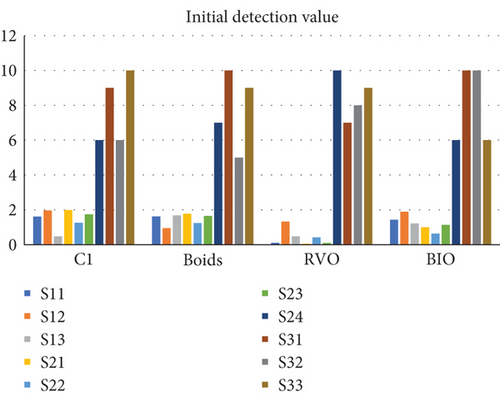
4.2. Group Model Based on Individual Rules
The swarm model simulates the movement of fish in a virtual ocean. As shown in Table 2 and Figures 5 and 6, when the quantity value is 2.75, M = 2.75, eavg = 3.14, ts = 3.39, MI = 4.81, Iavg = 3.21, and IT = 3.72, determine their behavioral changes based on determined behavioral conditions (e.g., in position, position, and velocity). As everyone in the group moves, the entire group is monitored for behavior. When the quantity value is 2.47, M = 2.47, eavg = 3.38, ts = 3.37, MI = 4.71, Iavg = 2.99, IT = 3.84, and the entire group will be monitored for behavior. Since each entity in this model only contains information within the scope of a regional perspective, there is no information on the entire global environment due to local administrative norms. Traditional drawing pipelines process columns and pixels based on a prearranged workspace and then drag graphics onto the screen. The main and main disadvantage of traditional drawing is that the columns of the drawing diagram are inserted into the drawing pipeline, no component can be changed during the whole machining process, and it is not easy. In a traditional recording pipeline, the pipeline receives columns of 3D graphics and then creates the pixels that appear on the screen.
| M | eavg | ts | MI | Iavg | IT |
|---|---|---|---|---|---|
| 2.75 | 3.14 | 3.39 | 4.81 | 3.21 | 3.72 |
| 2.47 | 3.38 | 3.37 | 4.71 | 2.99 | 3.84 |
| 2.1 | 3.47 | 3.91 | 4.67 | 3 | 3.44 |
| 2.15 | 2.01 | 3.64 | 4.04 | 2.45 | 3.56 |
| 2.07 | 2.45 | 3.54 | 4.22 | 3.06 | 3.43 |
| 2.47 | 3.27 | 3.17 | 4.59 | 3.11 | 3.64 |
| 2.36 | 3.92 | 3.16 | 4.31 | 3.02 | 3.03 |
| 2.65 | 3.93 | 3.98 | 4.73 | 2.96 | 3.24 |
| 2.79 | 2.87 | 3.93 | 4.91 | 2.38 | 3.38 |
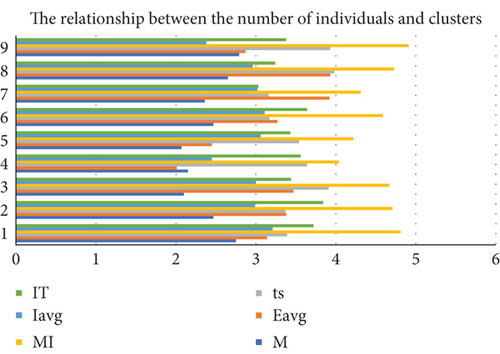
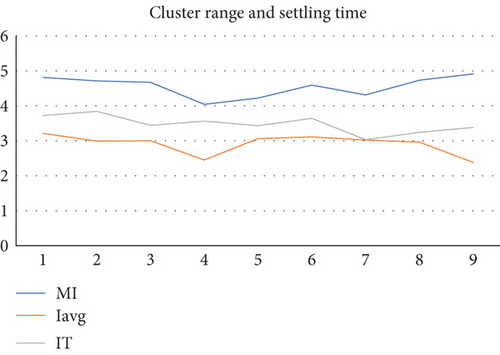
4.3. New Building Intelligent System
Most homes use a management approach based on an access management system. The central level control system includes lighting, fire protection, security, and building equipment systems as the basic system units, and the central station is used to control the operation of various types of systems. As shown in Table 3 and Figure 7, the number of operations isD0 = 9,D1 = 5,D2 = 9,D3 = 7,D4 = 7,D5 = 7,D6 = 9, andD7 = 10. As the scale of different types of controllers and converters in the home increases, so does the human activity of the smart home. The system switching between different systems is difficult, the center reliability is high, and the hardware standards are inconsistent. The average values in the test data are D0 = 6, D1 = 7, D2 = 6, D3 = 7, D4 = 6, D5 = 5, D6 = 8, and D7 = 7. Smart buildings involve many aspects of the social machine, such as building construction, which not only affects architecture but also design. Smart construction helps improve quality, shorten production time, save resources, and control costs. It is an important part of the structural transformation of the supply side of the construction industry and an important tool for the structural adjustment and modernization of the construction industry and greenhouses.
| Test port | D0 | D1 | D2 | D3 | D4 | D5 | D6 | D7 |
|---|---|---|---|---|---|---|---|---|
| Operations | 9 | 5 | 9 | 7 | 7 | 7 | 9 | 10 |
| Correct | 5 | 6 | 5 | 6 | 8 | 6 | 8 | 6 |
| Average | 6 | 7 | 6 | 7 | 6 | 5 | 8 | 7 |
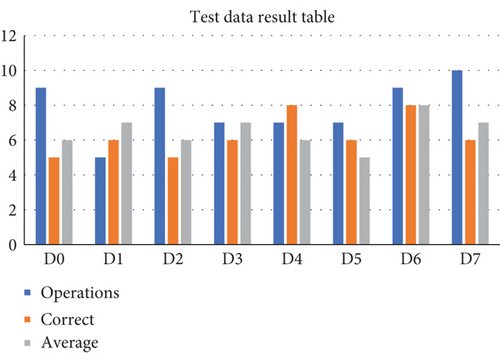
4.4. Spatial Layout of Intelligent Buildings
Decision space design follows higher architectural standards such as furniture, space, office buildings, and lighting, aiming to provide a comfortable working environment, communication environment, and decision support methods to help decision makers. As shown in Figure 8, the layout of the meeting space will choose quiet spaces, such as those on higher floors, to ensure privacy. The size and exact shape of the meeting space will depend on the number and size of the company’s workforce, as well as storage space for equipment used at the event. Designers should take care not to open the windows on the wall behind the meeting seats as much as possible, and decorate them with electrical appliances that can make sounds and block the ball, so as not to be disturbed by the outside world during the meeting. Office space——The building layout is reasonable, the lighting design is good, and it has the characteristics of safety, health, warmth, and comfort. To ensure safety and hygiene, avoid blind spots of wind pressure and fire prevention, and ensure the efficiency of single-room air separation, attention should be paid to the correct selection of building space and the design of adaptive equipment systems. For mobile office space, a space approach can be adopted. The hybrid space scheme divides the large office into perimeter spaces with exterior windows, and uses glass panels to isolate the interior spaces for use as offices. Spaces for secretaries and assistants and open communication spaces improve the office environment by adding decorations.
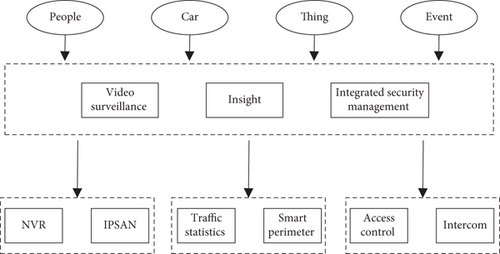
4.5. Optimization of Intelligent Control System
In BACnet intelligent control, the upper computer monitoring software uses the configuration program to read and monitor with the lower computer, monitor the data returned by each notebook computer, and drive the lower computer to perform similar tasks; the underlying computer communicates with the controller created by the PLC through the BACnet protocol. As shown in Table 4 and Figure 9, the operating system removes and configures the host computer from the computer monitoring system connected to the QT5. X2View is similar to the most popular configuration king with integrated functions. Project software is placed on the X2View and sent to the door or touch screen for processing and monitoring. In the driver configuration interface, you can set the application frame time of the monitoring node and the real-time measurement time of the record value recording time frame. The time of the application frame is set to 2000 ms, and the time of the write value in the start time frame is set to 500 ms. Since the number of monitoring nodes of the operator is 8, four kinds of monitoring nodes are created in the monitoring nodes. Due to the progress of project research and development, some can be prepared. In the future, more monitoring groups can be incorporated to include. The size type and address of the collection point are set in the tool’s features.
| Optimization | Difference | Inter-pedestrian | Path length | Progress |
|---|---|---|---|---|
| Before | 0.467 | 1.349 | 0.101 | 0.392 |
| G | 0.135 | 1.442 | 0.044 | 0.253 |
| GA+SA | 0.058 | 1.521 | 0.046 | 0.303 |
| GA+G | 0.069 | 1.311 | 0.037 | 0.272 |
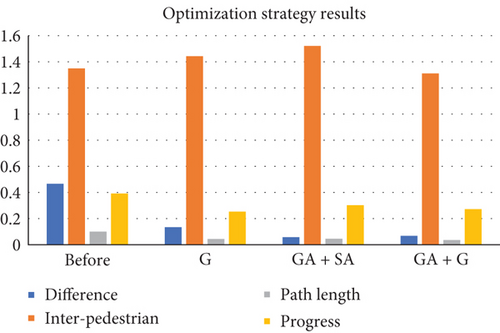
5. Conclusion
Smart buildings can store various types of data, analyze data at a faster speed, and quickly provide users with the most accurate and high-quality intelligent services through technical means. The main purpose is to meet the needs of users. Provide communication and a series of knowledge services for all professional participants, and provide comfortable working resources and working environment for all professional participants to ensure the smooth implementation of the project and meet the construction engineering requirements. In this study, the spatial layout and optimization of intelligent buildings are carried out based on biological population simulation, and the following conclusions are drawn: (1) The emergence of multicore or multicore graphics converters reduces the cost and popularity of high-performance software platforms and provides faster computing speeds for applications. A new platform and implementation method has been developed. Comparing marine biopopulation models relies on the i4Ocean platform. The i4Ocean platform is a computer platform for seascape information and virtual reality applications, including view management, production engine, and MVC core framework. The initial detection value of BIO is S11 = 1.43, S12 = 1.89, S13 = 1.22, S21 = 1, S22 = 0.64, S23 = 1.14, S24 = 6, S31 = 10, S32 = 10, and S33 = 6.2. The model simulates the movement of fish in a virtual ocean and determines their behavioral changes based on determined behavioral conditions (e.g., in position, position, velocity). As everyone in the group moves, the entire group is monitored for behavior. (3) Intelligent buildings involve many aspects of the social machine, such as building construction, which not only affects architecture, but also design. Smart construction helps improve quality, shorten production time, save resources, and control costs. It is an important part of the structural transformation of the supply side of the construction industry, and an important tool for the structural adjustment and modernization of the construction industry and greenhouses. (4) X2View is similar to the most popular configuration king, with integrated functions. Project software is placed on the X2View and sent to the door or touch screen for processing and monitoring. In the driver configuration interface, you can set the application frame time of the monitoring node and the real-time measurement time of the record value recording time frame.
Conflicts of Interest
The authors declared that they have no conflicts of interest regarding this work.
Acknowledgments
This work was supported by the Scientific Research Program of Hubei Provincial Department of Education (b2019293); the Humanities and Social Sciences Project of Hubei Provincial Department of Education (18y066); and the Research Project of Hubei Ethnic and Religious Affairs Committee (smzw201901).
Open Research
Data Availability
The experimental data used to support the findings of this study are available from the corresponding author upon request.




